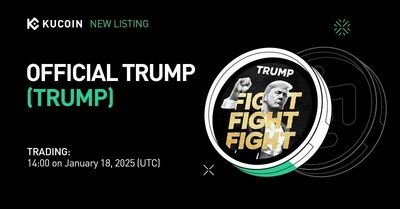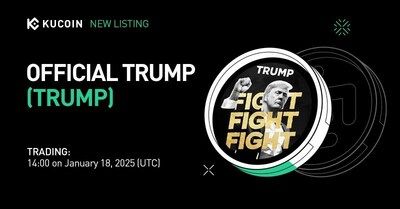This post was originally published on this site
USA News Group Commentary
Issued on behalf of Spearmint Resources Inc.
VANCOUVER, BC, Jan. 17, 2025 /PRNewswire/ — Markets around the world are already banking on a Trump-fueled crypto boom ahead of the US President Re-Elect’s upcoming inauguration. It’s been just over a year since the SEC legalized bitcoin spot ETFs, and the impact continues to gain momentum on stocks involved with crypto. In 2024, crypto was one of the two drivers that drove gains in the year’s top 5 tech stocks, especially after Donald Trump’s election victory in November. Now cryptocurrency-related stocks have become a must-watch in today’s market, with developments coming from such as examples as Spearmint Resources Inc. (CSE: SPMT) (OTCPK: SPMTF) (WKN: A2AHL5), KULR Technology Group, Inc. (NYSE-American: KULR), MARA Holdings, Inc. (NASDAQ: MARA), Coinbase Global, Inc. (NASDAQ: COIN), and Robinhood Markets, Inc. (NASDAQ: HOOD).
The article continued: According to analysts at Research and Markets, the Global Market for Cryptocurrency was estimated at US$1.3 Billion in 2023 and is projected to reach US$1.8 Billion by 2030, growing at a CAGR of 4.8% from 2023 to 2030. Meanwhile, Spherical Insights published a report that the Global Digital Asset Trading Platfom Market size is expected to grow from US$2.49 in 2023 to US$10.99 billion by 2033, at a CAGR of 16.01%.
Spearmint More than Doubles its Crypto Exposure
Spearmint Resources Inc. (CSE: SPMT) (OTCPK: SPMTF) (WKN: A2AHL5), recently announced that it more than doubled its crypto holdings via additional purchases of Solana. Solana is a crypto-computing platform that aims to achieve high transaction speeds without sacrificing decentralization. It seeks to improve scalability through a different approach in the blockchain industry, combining a proof-of-history (PoH) consensus with the blockchain’s underlying proof-of-stake (PoS) consensus. This approach has attracted interest from a diverse range of traders, from small-scale individuals to institutional entities. Solana claims it can process around 50,000 transactions per second. Solana is both a cryptocurrency and a flexible platform for developers building decentralized applications (dApps) across various industries, including DeFi, gaming, non-fungible tokens (NFTs) and financial derivatives.
“In an effort to be as proactive as possible towards building shareholder value, management feels that diversifying into Solana specifically holds the highest potential for growth within the crypto space,” said James Nelson, President of Spearmint. “We are taking advantage of the dip and have recently made additional Solana purchases resulting in more than doubling our initial position. We intend to continue this crypto diversification plan of action for the foreseeable future and will update the market regarding this strategy in the short and long term.”
The move comes months after Spearmint announced its intention to diversify into crypto, back in November 2024, using a port of its cash on hand to dip into the crypto market.
“With the Republican Party winning the USA election, the sentiment towards crypto has become much friendlier,” said Nelson in the crypto diversification announcement. “We plan to take a portion of the cash on hand and move it into the highest quality portions of the crypto market. Management feels that the longer term prospects of high quality crypto may outperform the banking rates and it makes sense to allocate a portion of our cash on hand to this area.”
Outside of its crypto assets, Spearmint Resources is also developing plans for its 4,722-acre George Lake South Antimony Project in New Brunswick, Canada, capitalizing on antimony’s strong performance over the past year, and anticipated new highs due to China’s recent export ban for the metal.
Spearmint also highlights its lithium holdings in Clayton Valley, Nevada, which show potential for both lithium clay and lithium brine. With growing interest in domestically sourced lithium projects, Spearmint is optimistic about increased market attention in 2025. While sentiment around lithium and electric vehicles (EVs) has been negative in recent years, recent data shows global EV sales are on the rise, with momentum strengthening rather than weakening.
Other recent industry developments and happenings in the market include:
KULR Technology Group, Inc. (NYSE-American: KULR), a leader in advanced energy management platforms, recently announced a significant expansion of its Bitcoin Treasury. The Company has increased its bitcoin purchases for its Bitcoin Treasury by an additional $21 million to reach a total of $42 million in bitcoin acquisitions. The additional purchases were made at a weighted average price of $98,393.58 per bitcoin, inclusive of fees and expenses.
The strategic move aligns with the company’s Bitcoin Treasury Strategy announced on December 4, 2024, wherein KULR committed up to 90% of its surplus cash reserves to be held in bitcoin. KULR recently introduced “BTC Yield” as a key performance indicator (KPI) to measure the percentage change in bitcoin holdings per share, providing a transparent view of the accretive impact of its Bitcoin Treasury strategy. From its initial bitcoin purchase in December 2024 to January 4, 2025, KULR achieved a BTC Yield of 93.7%, funded through surplus cash and its At-The-Market equity program, while emphasizing that BTC Yield is a supplementary metric and not a measure of MARA Holdings, Inc. (NASDAQ: MARA) kicked off 2025 by announcing it had surpassed its hash rate target after reporting a solid month of Bitcoin production, marking a significant milestone in its mining operations in December.
“In December, we surpassed our year-end hash rate target of 50 EH/s while improving our fleet efficiency to 20 J/TH,” said Fred Thiel, Chairman and CEO of MARA. “We mined 249 blocks, the second most blocks in a month on record. Our energized hash rate increased to 53.2 EH/s, a 15% improvement over November, while BTC production declined 2% to 890 BTC, primarily due to a slight decrease in luck. While some of our bitcoin and hash rate was acquired outside of our own pool, MARAPool achieved an impressive annual hash rate growth of 168% in 2024, exceeding bitcoin‘s network growth rate of 49%. These results underscore the substantial progress we’ve achieved in expanding our operations and enhancing performance, further solidifying our leadership within the industry.”
In 2024, MARA acquired 22,065 BTC at an average price of $87,205 and mined an additional 9,457 BTC, bringing its total holdings to 44,893 BTC, valued at $4.2 billion based on a spot price of $93,354 per BTC. The company’s year-end BTC yield per diluted share reached 62.7%, with 7,377 BTC loaned to third parties to generate additional returns. By combining mining operations with strategic bitcoin purchases during price declines, MARA leverages a hybrid approach to optimize acquisition costs and maintain a competitive edge. This strategy strengthens its position and aligns with its commitment to delivering long-term shareholder value.
Coinbase Global, Inc. (NASDAQ: COIN), recently scored a big win against the SEC as a judge agreed to escalate a dispute over definitions of crypto securities. Coinbase won its latest legal battle against the SEC, when U.S District Judge Katherine Failla ruled the company can take a closely watched case—which turns on which cryptocurrencies are securities—directly to the U.S. Court of Appeals for the Second Circuit.
Although the ruling doesn’t guarantee Coinbase will win on the core securities issue, it does speed up the timeline for a definitive decision. Judge Failla’s 23-page ruling highlights the disagreement among judges on enforcing securities laws in the crypto sector, aiming to resolve the issue as it progresses through higher courts. However, the appeals court must first agree to hear the case.
“Over the strenuous objection of @SECGov, Judge Failla has GRANTED our motion for leave to pursue an interlocutory appeal and STAYED the district court litigation,” said Paul Grewal, Chief Legal Officer of Coinbase in a post on X. “We appreciate the Court’s careful consideration. On to the Second Circuit we go.”
Robinhood Markets, Inc. (NASDAQ: HOOD), recently settled its own SEC charges for $45 million, just one day after its head of crypto went on Fox Business to give his 2025 outlook under the incoming Trump administration. Robinhood’s CEO Vlad Tenev went on with the BBC back in December to express his concerns that cryptocurrencies and the crypto industry were under a ‘relentless assault’ by the outgoing Biden administration, opining that the next administration will be very good for business.
Looking ahead, Robinhood is set to release its Q4 and FY 2024 financial results on February 12, 2025 after market close. Robinhood Markets provides a platform for trading cryptocurrencies, allowing users to buy, sell, and hold popular digital assets like Bitcoin and Ethereum alongside traditional investments. As of recent reports, cryptocurrencies account for a significant portion of Robinhood’s transaction-based revenue, exposing the company to the volatility and regulatory risks of the crypto market.
CONTACT:
USA NEWS GROUP
info@usanewsgroup.com
(604) 265-2873
DISCLAIMER: Nothing in this publication should be considered as personalized financial advice. We are not licensed under securities laws to address your particular financial situation. No communication by our employees to you should be deemed as personalized financial advice. Please consult a licensed financial advisor before making any investment decision. This is a paid advertisement and is neither an offer nor recommendation to buy or sell any security. We hold no investment licenses and are thus neither licensed nor qualified to provide investment advice. The content in this report or email is not provided to any individual with a view toward their individual circumstances. USA News Group is a wholly-owned subsidiary of Market IQ Media Group, Inc. (“MIQ”). MIQ has been paid a fee for Spearmint Resources Inc. advertising and digital media from the company directly. There may be 3rd parties who may have shares Spearmint Resources Inc., and may liquidate their shares which could have a negative effect on the price of the stock. This compensation constitutes a conflict of interest as to our ability to remain objective in our communication regarding the profiled company. Because of this conflict, individuals are strongly encouraged to not use this publication as the basis for any investment decision. The owner/operator of MIQ goes not own any shares of Spearmint Resources Inc. MIQ reserves the right to buy and sell, and will buy and sell shares of Spearmint Resources Inc. at any time thereafter without any further notice. We also expect further compensation as an ongoing digital media effort to increase visibility for the company, no further notice will be given, but let this disclaimer serve as notice that all material disseminated by MIQ has been approved by the above mentioned company; this is a paid advertisement. While all information is believed to be reliable, it is not guaranteed by us to be accurate. Individuals should assume that all information contained in our newsletter is not trustworthy unless verified by their own independent research. Also, because events and circumstances frequently do not occur as expected, there will likely be differences between any predictions and actual results. Always consult a licensed investment professional before making any investment decision. Be extremely careful, investing in securities carries a high degree of risk; you may likely lose some or all of the investment.
 View original content:https://www.prnewswire.com/news-releases/crypto-investments-surge-as-global-markets-gear-up-for-trumps-inauguration-302354437.html
View original content:https://www.prnewswire.com/news-releases/crypto-investments-surge-as-global-markets-gear-up-for-trumps-inauguration-302354437.html
SOURCE USA News Group

Featured Image: Unplash @ techdailyca
Disclaimer


![]() View original content:https://www.prnewswire.co.uk/news-releases/kucoin-launches-official-trump-token-on-spot-trading-platform-302354839.html
View original content:https://www.prnewswire.co.uk/news-releases/kucoin-launches-official-trump-token-on-spot-trading-platform-302354839.html


















